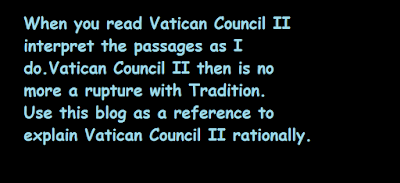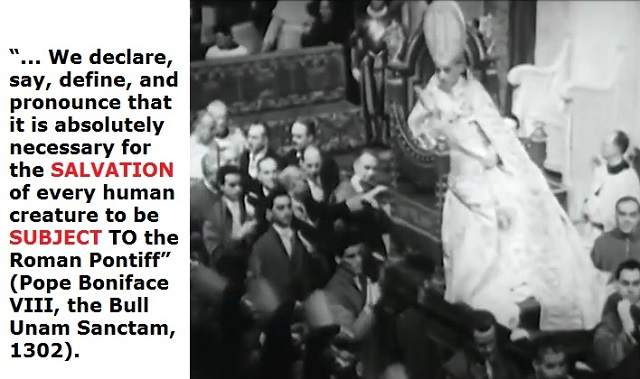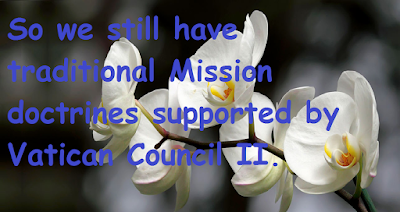 To the Pope and the Synod Fathers:
To the Pope and the Synod Fathers:
We, numerous bishops, priests, and Catholic faithful from all over the world, hereby affirm that the Instrumentum Laboris prepared for the coming Synodal assembly raises serious questions and very grave reservations, because of its contradiction of individual points of Catholic doctrine which have always been taught by the Church, as well as its contradiction of faith in Jesus Christ, the One Savior of all mankind. We have drawn up, following the classical method, four propositions in the form of “theses” summarizing the main points of the Instrumentum Laboris. In conscience and with great frankness, we affirm that the teaching of these theses is unacceptable.
1. Amazonian diversity, which is above all religious diversity, evokes a new Pentecost (IL 30): respect for this diversity means to recognize that there are other paths to salvation, without reserving salvation exclusively to the Catholic faith. Non-Catholic Christian groups teach other modalities of being Church, without censures, without dogmatism, without ritual disciplines and ecclesial forms (IL 138); the Catholic Church ought to integrate these modalities. Reserving salvation exclusively to the Creed is destructive of the Creed (IL 39).
Against this, among other texts: Dominus Iesus 14 and 16.
Lionel : This is meaningless for a Cushingite. Even Cardinal Ratzinger and the liberals would cite Dominus Iesus 14 and 16 to support the above point.
For him Dominus Iesus is Christological.Since with Cushingism he has rejected exclusive salvation in the Church.There is no ecclesiocentric ecclesiology for him. He admits it clearly in two theological papers of the International Theological Commission.
So Dominus Iesus 16 on the Church does not say that every one needs to enter the Church for salvation( to avoid Hell). Since there are exceptions to the past ecclesiology, he would say all who are saved are saved through Jesus and the Church. So non Catholics could be saved in their religions, the New Theology would suggest, without knowing and believing in Jesus.So Cardinal Ratzinger would support the point above of the Working Paper, while citing Dominus Iesus 14 and 16.Similarly he would interpret Dominus Iesus 21 which does not affirm exclusive salvation in the Catholic Church with Feeneyite-reasoning.The amibigous Cushingite passages in Vatican Council II are interpreted as objective exceptions to exclusive salvation in the Catholic Church.
Against this I would cite Vatican Council II, Dominus Iesus and other magisterial documents interpreted with Feeneyism( hypothetical cases are only hypothetical) instead of irrational but common Cushingism ( hypothetical and theoretical cases are objective non Catholics saved outside the Catholic Church without faith and baptism in 1865-2019).
2. The teaching of Pan-Amazonian theology, which takes special account of myths, rituals, and celebrations of indigenous cultures, is required in all educational institutions (IL 98 c 3). Non-Christian rites and celebrations are proposed as “essential for integral salvation” (IL 87) and we are asked to “adapt the Eucharistic rite to their cultures” (IL 126 d). On rituals: IL 87, 126.
Against this: Dominus Iesus 21.
DOMINUS IESUS
21. With respect to the way in which the salvific grace of God — which is always given by means of Christ in the Spirit and has a mysterious relationship to the Church — comes to individual non-Christians, the Second Vatican Council limited itself to the statement that God bestows it “in ways known to himself”.83 Theologians are seeking to understand this question more fully. Their work is to be encouraged, since it is certainly useful for understanding better God's salvific plan and the ways in which it is accomplished. However, from what has been stated above about the mediation of Jesus Christ and the “unique and special relationship”84 which the Church has with the kingdom of God among men — which in substance is the universal kingdom of Christ the Saviour — it is clear that it would be contrary to the faith to consider the Church as one way of salvation alongside those constituted by the other religions, seen as complementary to the Church or substantially equivalent to her, even if these are said to be converging with the Church toward the eschatological kingdom of God.
Certainly, the various religious traditions contain and offer religious elements which come from God,85 and which are part of what “the Spirit brings about in human hearts and in the history of peoples, in cultures, and religions”.86 Indeed, some prayers and rituals of the other religions may assume a role of preparation for the Gospel, in that they are occasions or pedagogical helps in which the human heart is prompted to be open to the action of God.87 One cannot attribute to these, however, a divine origin or an ex opere operato salvific efficacy, which is proper to the Christian sacraments.88 Furthermore, it cannot be overlooked that other rituals, insofar as they depend on superstitions or other errors (cf. 1 Cor 10:20-21), constitute an obstacle to salvation.89
|
Lionel: Against this Vatican Council II ( Feeneyite). It has an exclusivist ecclesiology.
Vatican Council II is not only Christological it is ecclesiocentric when Lumen Gentium does not contradict the past exclusivist ecclesiology, Ad Gentes does not contradict traditional mission and exclusive salvation, there being no known exceptions and Unitatitis Redintigratio does not contradict the centuries old ecumenism of return.Nostra Aetate does not contradict Ad Gentes 7 which states all need faith and baptism for salvation and there is nothing in Dignitatis Redintigratio to oppose the proclamation of the Social Reign of Christ the King in a Catholic State.1
So Vatican Council II is really saying outside the Catholic Church there is no known salvation and all need to be members of the Church with faith and baptism to avoid Hell ( for salvation).The theology still is outside the Church there is no salvation.
3. Among the various Loci Theologici (that is, among the various sources of theology, such as Sacred Scripture, the Councils, the Fathers of the Church) there is included the territory [of the Amazon] and the cry of its peoples. (IL 18, 19, 94, 98 c 3, 98 d 2, 144).
Against this: Dei Verbum 4, 7, 10.
Dei Verbum
4. Then, after speaking in many and varied ways through the prophets, "now at last in these days God has spoken to us in His Son" (Heb. 1:1-2). For He sent His Son, the eternal Word, who enlightens all men, so that He might dwell among men and tell them of the innermost being of God (see John 1:1-18). Jesus Christ, therefore, the Word made flesh, was sent as "a man to men." (3) He "speaks the words of God" (John 3;34), and completes the work of salvation which His Father gave Him to do (see John 5:36; John 17:4). To see Jesus is to see His Father (John 14:9). For this reason Jesus perfected revelation by fulfilling it through his whole work of making Himself present and manifesting Himself: through His words and deeds, His signs and wonders, but especially through His death and glorious resurrection from the dead and final sending of the Spirit of truth. Moreover He confirmed with divine testimony what revelation proclaimed, that God is with us to free us from the darkness of sin and death, and to raise us up to life eternal.
The Christian dispensation, therefore, as the new and definitive covenant, will never pass away and we now await no further new public revelation before the glorious manifestation of our Lord Jesus Christ (see 1 Tim. 6:14 and Tit. 2:13).
__________________________
7. In His gracious goodness, God has seen to it that what He had revealed for the salvation of all nations would abide perpetually in its full integrity and be handed on to all generations. Therefore Christ the Lord in whom the full revelation of the supreme God is brought to completion (see 2 Cor. 1:20; 3:13; 4:6), commissioned the Apostles to preach to all men that Gospel which is the source of all saving truth and moral teaching, (1) and to impart to them heavenly gifts. This Gospel had been promised in former times through the prophets, and Christ Himself had fulfilled it and promulgated it with His lips. This commission was faithfully fulfilled by the Apostles who, by their oral preaching, by example, and by observances handed on what they had received from the lips of Christ, from living with Him, and from what He did, or what they had learned through the prompting of the Holy Spirit. The commission was fulfilled, too, by those Apostles and apostolic men who under the inspiration of the same Holy Spirit committed the message of salvation to writing. (2)
But in order to keep the Gospel forever whole and alive within the Church, the Apostles left bishops as their successors, "handing over" to them "the authority to teach in their own place."(3) This sacred tradition, therefore, and Sacred Scripture of both the Old and New Testaments are like a mirror in which the pilgrim Church on earth looks at God, from whom she has received everything, until she is brought finally to see Him as He is, face to face (see 1 John 3:2).
_________________________
10. Sacred tradition and Sacred Scripture form one sacred deposit of the word of God, committed to the Church. Holding fast to this deposit the entire holy people united with their shepherds remain always steadfast in the teaching of the Apostles, in the common life, in the breaking of the bread and in prayers (see Acts 2, 42, Greek text), so that holding to, practicing and professing the heritage of the faith, it becomes on the part of the bishops and faithful a single common effort. (7)
But the task of authentically interpreting the word of God, whether written or handed on, (8) has been entrusted exclusively to the living teaching office of the Church, (9) whose authority is exercised in the name of Jesus Christ. This teaching office is not above the word of God, but serves it, teaching only what has been handed on, listening to it devoutly, guarding it scrupulously and explaining it faithfully in accord with a divine commission and with the help of the Holy Spirit, it draws from this one deposit of faith everything which it presents for belief as divinely revealed.
It is clear, therefore, that sacred tradition, Sacred Scripture and the teaching authority of the Church, in accord with God's most wise design, are so linked and joined together that one cannot stand without the others, and that all together and each in its own way under the action of the one Holy Spirit contribute effectively to the salvation of souls.
Lionel : Against this Vatican Council II (Feeneyite).It affirms the past exclusivist ecclesiology based upon John 3:5 and Mark 16:16.
Vatican Council II( Cushingite) would wrongly suggest that there are known exceptions in 2019 to the interpretation of the dogma extra ecclesiam nulla salus according to the Magisterium and missionaries of the 16th century.It would suggest that there are known exceptions to John 3:5 and Mark 16:16.
____________________________
4. It is suggested that ordination be conferred on older persons who have families and to confer “official ministries” on women. There is thus proposed a new vision of Holy Orders which does not come from Revelation, but from the cultural usages of the Amazonian people (which provide for a rotating system of authority, among other things). Therefore, there ought to be separation made between the priesthood and the munus regendi (IL 129 a 2, 129 a 3, 129 c 2).
Against this: Lumen Gentium 21, Presbyterorum Ordinis 13, Pastores Dabo Vobis 26; and also: the entire document Sacerdotalis Coelibatus, especially 21 and 26, Ordinatio Sacerdotalis1, 3 and 4; Pastores Dabo Vobis 29.
Lionel: Against this Vatican Council II( Feeneyite). Will the cardinals, bishops, priests and Religious Sisters affirm exclusive salvation in the Catholic Church with LG 8, LG 14, LG 16, UR 3, NA 2, Gs 22 etc not being objective exceptions?
No. They will continue to interpret Vatican Council II and other magisterial documents with irrational Cushingism. They will use a false premise to create a rupture with Tradition( Athanasius Creed, Syllabus of Errors, EENS , Catechism of Pope Pius X etc).-Lionel Andrades
_________________________________
Coetus Internationalis Patrum Working Group October 1, 2019
1
The anonymous Coetus Internationalis Patrum Working Group (International Group of Fathers) did not choose to interpret Vatican Council II with Feeneyism; without the false premise,making the Council ecclesiocentric in its ecclesiology.So with Vatican Council II being only Christological for them the citation from Dominus Iesus 14 and 16 was enough.Since with the New Theology of Rahner and Ratzinger,everyone is saved through Jesus and the Church and so they do not necessarily have to become members of the Catholic Church or even know or believe in Jesus.
https://eucharistandmission.blogspot.com/2019/10/the-anonymous-coetus-internationalis.html
Cardinals Hummes, Baldiserri,Ladaria and others at the Amazon Synod must be told that Vatican Council II is being interpreted on the blog Eucharist and Mission(Lionel's Blog) as having an ecclesiocentric ecclesiology which negates their 'only Christological' interpretation of the Council.
https://eucharistandmission.blogspot.com/2019/10/cardinals-hummes-baldiserriladaria-and.html
Vatican Council II is not only Christological it is ecclesiocentric when Lumen Gentium does not contradict the past exclusivist ecclesiology, Ad Gentes does not contradict traditional mission and exclusive salvation, there being no known exceptions and Unitatitis Redintigratio does not contradict the centuries old ecumenism of return.Nostra Aetate does not contradict Ad Gentes 7 which states all need faith and baptism for salvation and there is nothing in Dignitatis Redintigratio to oppose the proclamation of the Social Reign of Christ the King in a Catholic State




























